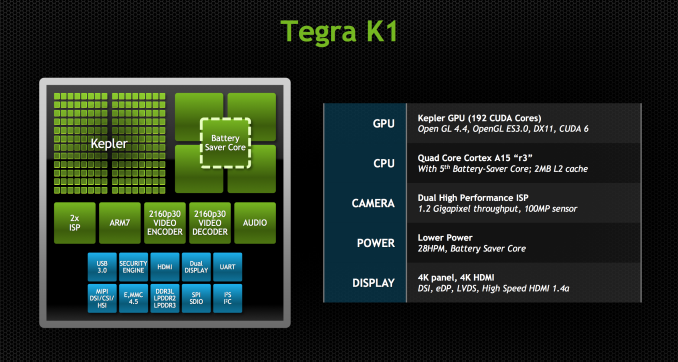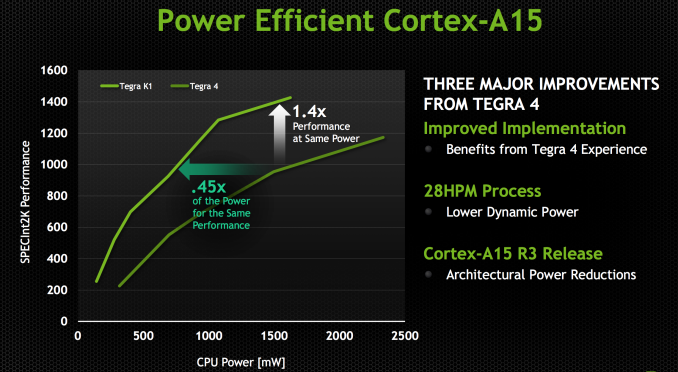NVIDIA Tegra K1 Preview & Architecture Analysis
by Brian Klug & Anand Lal Shimpi on January 6, 2014 6:31 AM EST
NVIDIA has taken to using CES as its platform for launching members of its Tegra mobile SoC family. This year was no different as it shifted branding a bit in its announcement of the Tegra K1, formerly known as Project Logan.
With Tegra 2 NVIDIA’s big selling point was being first to dual-core in Android. Tegra 3 attempted to do the same with being first to quad-core. Tegra 4 just made things faster. Tegra K1 on the other hand does away with the gimmicks and instead focuses on fundamentals.
The SoC will come in two versions, one version with a quad-core (4+1) Cortex-A15, and one that leverages two of NVIDIA’s own 64-bit ARMv8 Denver CPUs. More importantly, they both ship with a full implementation of NVIDIA’s Kepler GPU architecture. In fact, Tegra K1 marks a substantial change in the way NVIDIA approaches mobile GPU design. From this point forward, all mobile GPUs will leverage the same architectures as NVIDIA’s desktop parts. As if that wasn’t enough, starting now, all future NVIDIA GeForce designs will begin first and foremost as mobile designs. NVIDIA just went from playing with mobile to dead serious in a heartbeat.
Tegra K1 will also be NVIDIA's launch vehicle for Project Denver, it's first fully custom ARMv8 CPU core. More on that in a bit.
CPU Option 1: Quad-Core ARM Cortex A15
Tegra K1 will ship in two configurations. The first went into production at the end of December 2013, is shipping to OEMs this quarter and will be in devices, allegedly, in the first half of 2014. This first configuration is based on ARM’s Cortex A15 CPU core.
Much like Tegra 4, the A15 version of Tegra K1 features four Cortex A15s synthesized for high frequencies and a fifth Cortex A15 that’s optimized for low power/frequency operation. The fifth core, what NVIDIA likes to call a shadow or companion core, is swapped in during periods of very low CPU usage (e.g. idle, screen off in your pocket updating new tweets/emails). As CPU demands grow the companion core is switched out for one of the four high performance cores, then two, then three and finally all four can be plugged in at once (but never five).
Tegra K1 ships with a newer revision of the Cortex A15 (r3p3) than what was in Tegra 4 (r2p1). ARM continuously updates its processor IP, with each revision bringing bug fixes and sometimes performance improvements. In the case of Tegra K1’s A15s, the main improvements here have to do with increasing power efficiency. With r3p0 (which r3p3 inherits) ARM added more fine grained clock gating, which should directly impact power efficiency.
The combination of the newer Cortex A15 revision and the move to 28nm HPM give Tegra K1 better performance at the same power consumption or lower power consumption at the same performance level. The reality tends to be that mobile OEMs will pursue max performance and not optimize for a good performance/power balance, but it’s at least possible to do better with Tegra K1 than with Tegra 4.
The max CPU clock goes up from 1.9GHz to 2.3GHz, a direct result of the move to 28nm HPM; 2.3GHz is the max CPU clock regardless of the number of active cores. The max performance increase over Tegra 4 running at max clocks will be just over 20%.
NVIDIA hasn’t made any changes to the L1/L2 cache configuration with Tegra K1. We’re still dealing with a shared 2MB L2 and 32KB/32KB L1s (I$+D$) per core.
The companion core can scale up to 1GHz, but tends to run at around 500MHz.
Feeding the CPU (and GPU) cores is a 64-bit wide LPDDR3 memory interface. NVIDIA will offer Tegra K1 in PoP, discrete and another package revision for standard clamshell notebook use.












88 Comments
View All Comments
easp - Wednesday, January 8, 2014 - link
So, it seems to me that 8 of these Denver cores would offer similar general purpose compute performance to a dual socket server from ~5-6 years ago, and yet, would make up a minuscule % of die area on a Tesla-class GPU die...Krysto - Saturday, January 11, 2014 - link
Some also say a Denver core should equal the Sandy Bridge core in performance, which would be quite impressive. That's what I have in my laptop, and it was a pretty high-end one 2 years ago.OreoCookie - Sunday, January 12, 2014 - link
Who wrote that, can you provide a link? I haven't seen any such claims. And I'm fairly sure nVidia would have mentioned that during the press event. Apple's A7 packs about the same punch as a Core 2 Duo, so it'd not be out of the question, but I'd be more cautious, especially seeing how high Intel's cpus turbo these days.PC Perv - Saturday, January 11, 2014 - link
How can you make so many definitive statements over what was essentially a PR pitch? It's too bad there is no "critics" or ombudsman to hold these bloggers accountable over time. (Granted that is also why these bloggers will never garner respects from mainstream media) These bloggers seemingly get away with anything they say as long as they keep their industry friends happy.If anyone wants to know what I am talking about, go back 2 ~ 3 years and check these clowns' articles. And check if they ever, i mean EVER, acknowledge their misjudgments or stupidity.
PC Perv - Saturday, January 11, 2014 - link
For instance, do you guys have any follow up on Tegra 4i?http://www.anandtech.com/show/6787/nvidia-tegra-4-...
Or ist it just the way it is with you guys? Just blow fanfare whenever OEM does a press conference, and completely forget about it in less than a year?
Have you no shame?
TheJian - Tuesday, January 14, 2014 - link
What fanfare? T4i is a Q1 product and the modem just got certified on ATT last month or so. The whole point of the T4i is the modem and phones so what is the problem? NV already showed it doing 150mbps (an update from 100mbps preview info) and this hasn't even been rolled out yet (anybody else running this besides Honk Kong/Singapore?). What do you want them to report? This product has been PULLED IN along with K1 at the cost of some T4 delay and sales. This is not news and everyone (even this NV hating site) has reported it :) T4i if late at all is only because of the modem awaiting which after checking happened Early Nov.Not sure this new modem speed is even interesting with caps we have today. At 50mbps on cable I can clock ~325GB or so pegged all day (that's north of 10TB/month). Even Hong Kong has a 10GB cap which is what, like 5x USA caps at 2GB usually? Even in HK that's only ONE 1080p flick and some browsing? I hope we start seeing Cell phone bill lawsuits soon that tie up these CAPPED companies so badly they are forced to stop this crap just due to litigation cost fears. But I think this is probably a pipe dream until google or someone else can offer unlimited mobile.
IE, google mentions rolling out Gbit internet in Austin, and ATT goes on immediate defense announcing huge speed upgrades (20x faster to 300mbps) and a future upgrade past that on the books not long after. So it is terribly expensive and not doable before google, but the same week google announces their roll-out, ATT can suddenly roll-out a huge upgrade and BEAT google's roll-out dates...LOL. But to match google's prices ($70) you have to OK them spying on you...ROFL. At least Google forced the updates.
http://www.theverge.com/2013/12/11/5200250/at-t-be...
Then claims they can deny google access to poles a few days later:
http://arstechnica.com/tech-policy/2013/12/why-att...
We can only hope the city votes on 23rd (next week) to allow low pole access pricing. Hard to say google would lose offering free internet to 100 libraries and public joints in the city that the CITY chooses, but they already delayed so maybe they're stupid or bribed heavily. :)
Maybe google just needs to announce everywhere and get ATT etc to announce matching $70 pricing then just say "just kidding". :) At worst they seem to easily force monopolies to respond as shown here. I hope they do the same in phones, amazon and apple too (heck MS also). We need all these big tech dogs to bark at cell providers big time and threaten their business models in any way they can. Competition from outsiders is sorely needed in cell or we'll be stuck with Verizon/ATT etc caps forever.
phoenix_rizzen - Thursday, January 16, 2014 - link
Rogers in Canada has 150 Mbps LTE using their 2600 MHz spectrum. It's been live for about a year now.They ran a speedtest competition around the time they lit up the first 2600 MHz towers in Ontario, and there were a *lot* of entries showing over 90 Mbps entries. It's listed somewhere on their Redboard blog.
My phone only does 100 Mbps LTE, and our town doesn't yet officially have LTE (there are 2 towers with it enabled out of the dozen or so towers in town), but I can get a consistent 40 Mbps on speedtests, with the occasional jump over 70.
So, if backward old Canada can get 150 Mbps LTE working, anywhere should be able to. :)
Oh, and 6 GB data plans are very common up here.
tipoo - Thursday, November 6, 2014 - link
I wonder if the code morphing has anything to do with the Nexus 9s performance inconsistency? Does amazing in most singular benchmarks, but when thrown multitasking or unpredictable code it chokes.